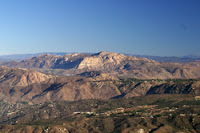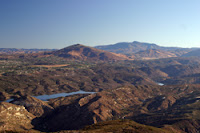
 Sometime last year I discovered that we had a nature reserve practically in our own back yard. It's called the "Sycuan Peak Ecological Reserve", and it's part of the state system of reserves, managed by the California Department of Fish & Game. Sycuan Peak itself is smack in the middle of this reserve, just southwest of Loveland reservoir. The southern edge of the reserve borders Lawson Valley Road, just three miles from our home.
Sometime last year I discovered that we had a nature reserve practically in our own back yard. It's called the "Sycuan Peak Ecological Reserve", and it's part of the state system of reserves, managed by the California Department of Fish & Game. Sycuan Peak itself is smack in the middle of this reserve, just southwest of Loveland reservoir. The southern edge of the reserve borders Lawson Valley Road, just three miles from our home.
Within a hundred feet or so of the 2.5 mile marker on Lawson Valley Road is an unmarked (though there used to be a sign) rugged four-wheel drive road up the small peak to the north. This is the "trail" to Sycuan Peak, actually an old and heavily eroded jeep trail. Much of the road is actually still drivable by four-wheel (though I don't believe you're actually supposed to drive on it), but toward the top it's pretty much impassable by vehicle. This morning Jim Barnick and I hiked up to the peak with our two dogs (Mo'i and Lea); this was the first time we'd ever done so.
The trail is just a mile long, but steep, with an 850 foot elevation gain in that short distance. The views all along the trail are spectacular, perhaps especially for someone living in that area. From the top we had the best view of Loveland Reservoir that I've ever had from the ground (first photo). The view to the north included a great view of Cajon Mountain (second photo). To the west we had a spectacular, nearly uninterrupted view of the Pacific coastline — only Miguel Peak punctures the horizon from Sycuan Peak, and by less than a degree. The skies were a bit hazy today, especially to the west; we'll do this again on a really clear winter day and I'll take a panorama.
Our dogs thoroughly enjoyed this hike. No surprise there! But one thing that was a little surprising: our agile little female (Lea) actually got a little tuckered out on the way up. She usually tries to pull us up the hill whenever we're walking with her; she's incurably eager to see what's around the next bend. This time, though, she started slowing down at around the 2/3 mark — enough so that I got concerned she might be overheating or something, and we stopped to rest. That was the cure — a few minutes standing still and she was good as new. At the top we gave both dogs a nice drink by pouring water into our cupped hand. Both of them had a little trouble figuring that out <smile>.
One interesting factoid about the Sycuan Peak Reserve: it is the primary remaining habitat for a very rare plant: Nolina interrata, commonly known as the "Dehesa Beargrass". From the U.S. Fish and Wildlife Service site:
A total of about 9,000 Nolina interrata plants are known (FWS 1998a, TNC 1998).
There are nine populations of Nolina interrata in San Diego County, all within a 15.6 square km (6 square mile) area in the Dehesa Valley, immediately east of El Cajon, California and from three small, somewhat disjunct populations in northern Baja California, Mexico. There are no records of extirpated populations (FWS 1998a, TNC 1998).
About two-thirds of all populations, and 90-100 percent of all major populations, are protected on reserve lands owned and managed by The Nature Conservancy (TNC) at McGinty Mountain and by the California Department of Fish and Game (CDFG) at Sycuan Peak. The protection afforded by the establishment of the Sycuan Ecological Preserve occurred subsequent to the proposal to list Nolina interrata. The remaining few occurrences are small and are on private lands (FWS 1998a).
Jim and I did not search for this plant during our hike; we'll save that for another day. Not being plant experts, I suspect we may have a little trouble positively identifying it even if we did manage to find it <smile>.
Nine thousand individuals sounds like an extremely small population, at risk all the more because they're located in just a few concentrated populations. The FWS web site mentions that Nolina interrata flowers profusely after a fire; parts of the Sycuan Peak Reserve (if I have got the borders correctly) burned in the Pines fire of 2001. We can hope for a bit of a comeback from that. Also in the FWS web site is mention that at least one of the isolated populations appears to be composed entirely of genetic clones of one plant; another risk factor. There's more information on this plant (including photos) here, here, and here.
The geocachers have discovered Sycuan Peak as well. Jim and I didn't try to find this particular one, but it's clear from the description that it's somewhere very close to the peak.
As usual, click on the photos for a larger view.

No comments:
Post a Comment